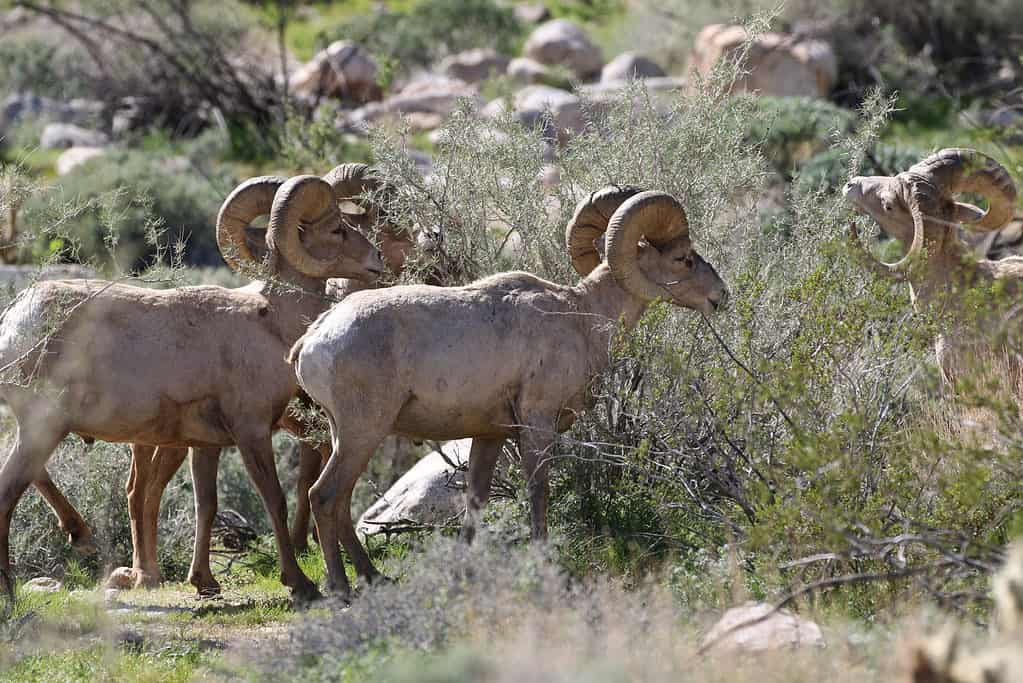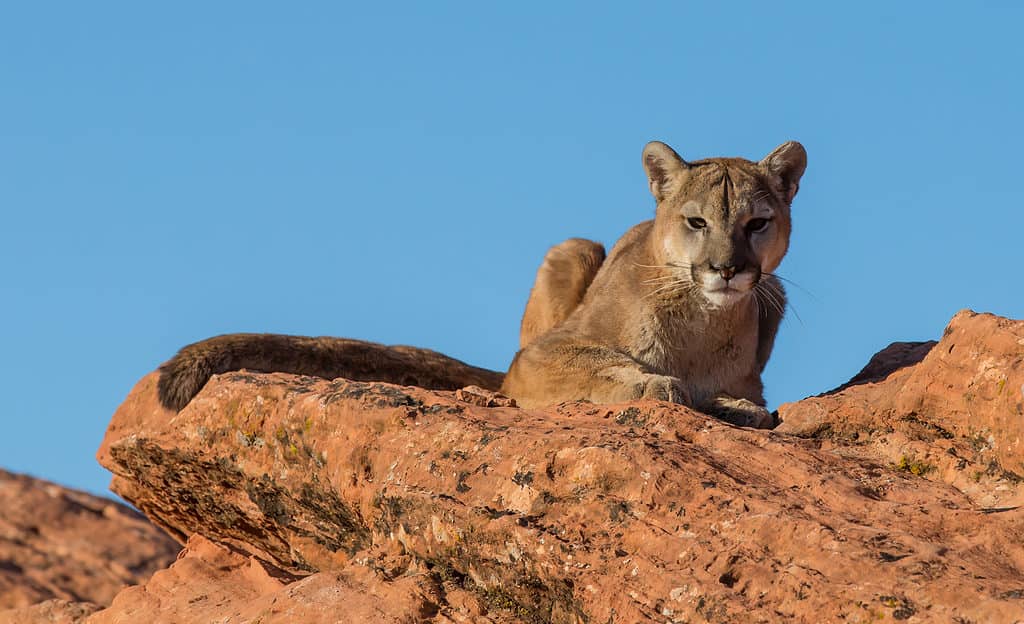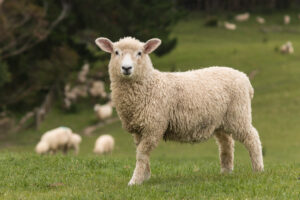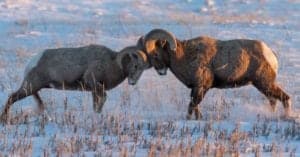The desert sheep is a subspecies of bighorn sheep. You can find it in eastern California, Southern Utah, and Nevada deserts. It has a muscular body with chocolate brown fur, but its rump, belly, and muzzle are white. The desert sheep’s weight ranges from 160 to 250 pounds. But the males are heavier than the females and can weigh over 350 pounds.
Desert sheep live in open and rugged habitats like canyons, cliffs, and washes. Their excellent vision, acute sense of smell, and hearing help them detect and escape predators.
During summer, desert sheep mainly eat clover, sedges, and grasses. They change to feeding on woody planks such as sage and willow in the winter months. In the desert, the sheep will eat plants like cacti and holly.
Desert sheep are ruminants (they have a four-part stomach) that allow them to take large food portions quickly. This helps them rechew and digest food without worrying about predators after returning to their habitats. In addition, during digestion, the sheep absorb moisture, allowing them to go without water for a long time.
Today, we discover the largest desert sheep ever caught in California and the world. We also explore the sheep’s history, threats, adaptations, and importance to the ecosystem.

Desert bighorn sheep live in open and rugged habitats in California, Utah, and Nevada.
©Randy Bjorklund/Shutterstock.com
The Largest Desert Sheep Ever Caught in California
Jason Hairston recorded the largest desert sheep ever in California. According to the scoring scale of Boone & Crockett, the huge ram had an impressive score of 190 4/8 points. The horns of this Goliath sheep had a length of 40 inches with a base circumference of 16.5 inches.
The Largest Desert Sheep Ever Caught in the World
The world’s largest desert sheep was caught in Mexico’s Baja Peninsula by Carl M. Scrivens in 1941 during his hunting trip. The sheep’s head had an excellent score of 205-1/8.
The History of Desert Sheep
Desert sheep were mainly found in the Borrego Desert for the longest time — about 10,000 years ago. After that, they moved to Siberia, which extended their range in western North America.
Today, you’ll still find desert sheep in Baja, California, but their population has dwindled to around 3% of the estimated numbers in the 1800s, which was 1.5 million. The decline is a result of human activities including:
- Mining
- Grazing
- Homesteading
- Overhunting.

The population of desert sheep in Baja, California has dwindled to o around 3% of the estimated numbers in the 1800s.
©Jilll Richardson/Shutterstock.com
Breeding and Lifespan
When the mating season comes, the rams compete to determine female access rights. The main determinants of male dominance status are overall vigor, age, and horn size. Male rams of less than seven years can only mate if the dominant rams in the group die.
The peak season of rutting is in August and September. Gestation takes 150-180 days. Desert sheep bear lambs during any season, but many births happen from January to April.
A few weeks after birth, lambs create their bands and only look for their mothers to suckle occasionally. They get completely weaned after six months old.
Ewes start breeding at the age of two to three years. Most desert sheep live for over 10 years and have a maximum life span of 20 years.

Desert sheep bear lambs during any season, but many births happen from January to April.
©iStock.com/Rainbohm
Main Threats of Desert Sheep
Several factors threaten desert bighorn sheep, including diseases, predation, and human disturbance.
Diseases
The desert sheep population is affected by diseases caused by viruses, parasites, and bacteria. They include:
- Parainfluenza 3 (PI-3)
- Contagious ecthyma
- Epizootic Hemorrhagic Disease
- Bovine Respiratory Syncytial Virus
- Leptospirosis
- Scabies
- Sinusitis
- Bluetongue (BTV).
Of all the above, respiratory diseases are the main cause of the decline of desert sheep. Over 14,000 adult sheep died from these diseases from 1970 to 2014.
Mycoplasma ovipneumoniae bacteria is the main agent of pneumonia in desert sheep. Also, bacteria like Pasteurellaceae and other factors like paranasal sinus tumors increase the severity of disease in herds.
Desert sheep lack immunity to pneumonia types found in domestic sheep. As a result, exposure to such pneumonia bacteria can lead to serious catastrophes. In addition, desert sheep can contract spillover of M. ovi if they come into contact with infected domestic sheep or goats.
Predation
The predators that kill the desert sheep include:
Mountain lions are the main predators of desert sheep. They have contributed to significant losses of these sheep since some lions view them as their main prey.
Predators are not only dangerous because they kill individual desert sheep, but they also threaten the entire population by reducing their numbers. As a result, the ability of the sheep to survive long-term is impacted negatively by the changing of their population dynamics.

Mountain lions are the main predators of desert sheep.
©Warren Metcalf/Shutterstock.com
Human Disturbance
Urban development has led to significant consequences on the desert sheep population. First, it has contributed to the habitat loss of these sheep, leading to a great decline in their numbers.
In 1999, the U.S. Fish and Wildlife Service named the California desert sheep an endangered one. The main contributing factor to this report was human disturbances.
Roads and highways cause habitat fragmentation hence stopping movement between neighboring populations. But desert sheep can survive predictable human activities like hiking and in less disturbed areas like parks and suburban lawns.
Overgrazing by domestic livestock also threatens the desert sheep’s population. It occurs when too many animals graze on a piece of land for a long time.
The animals eat the plants, making it impossible for them to grow back. As a result, the desert sheep lack food sources, decreasing their population.
Camping and off-roading can erode soils and destroy vegetation cover, causing vegetation damage. It can also introduce weed seeds into the ecosystem and expose rare plant species to trampling by humans or vehicles.
Adaptations of Desert Sheep
Desert sheep live in arid environments and can survive long periods of drought. This is because they have a keen sense of smell, which helps them find food and water in times of scarcity.
The desert sheep have the following adaptations:
Hard and Strong Feet
The hoofs of desert sheep are hard and strong, with a rubbery center to protect them from cracking and crumbling in the hot desert. The feet also have thick pads that protect them from sharp rocks and cactus spines. In addition, the hoofs are covered with keratin layers, a tough, fibrous protein found in hair, fingernails, and wool.
Dark Coloration
Dark coloration helps the desert sheep blend with their surroundings and avoid predators.
A Complex Digestive System
Desert sheep can digest various plants and grasses. It has a four-chambered stomach and caecum (a blind pouch), making it possible for the animal to digest cellulose. The desert sheep also produces large amounts of saliva when eating, which helps break down food before it enters the stomach.
A Thick Coat
The sheep’s thick coat helps it retain heat in cold weather. The skin has two layers: a dense undercoat and a longer outer coat of coarse guard hairs that keep the inner layer warm by trapping air between them.
The guard hairs are thickest on their back, protecting the body from rain or snow by shielding it from direct contact with precipitation.
Sensory Perception
Desert sheep have a keen sense of smell, hearing, and sight. Their eyesight is so good that they can spot predators from far away. In addition, the ears are on both sides of their head, so they can hear from any direction.
Digging Ability
Desert sheep’s horns help them dig into the ground to find food or water. They also use them to fight off predators such as mountain lions and coyotes. The horns have special ridges along the outside edge that help them cut through dirt easily.

The hoofs of desert sheep are hard and strong, with a rubbery center to protect them from cracking and crumbling in the hot desert.
©iStock.com/twildlife
What to Do When You Encounter a Desert Sheep
If you have ever been in the presence of a desert sheep, you know that these animals are large, powerful, and have sharp horns. However, they are also fast and agile, so if they feel threatened, they can be dangerous.
If you come across a desert sheep, here is what to do:
Keep Dogs Away From Their Young
As with any wild animal, you should leave desert bighorn sheep alone if you see them. Likewise, if you have dogs, keep them away from the sheep.
The best way to do this is by using a leash and always staying close to your dog. It may be attacked if your dog gets too close to a bighorn ram or ewe.
Don’t Approach Them Too Closely
Don’t get too close to these animals when observing them in their natural habitat. They are extremely protective of their young and will attack if they feel their offspring might be in danger from approaching humans or other predators.
Even if they are not protecting anything at the moment, it is still best not to get too close because they may become overprotective out of fear that you could pose a threat at any time.
If you are hiking, stay on established trails to avoid interfering with the sheep’s natural movements or habitat. If you are camping, camp at least 100 feet away from water sources and trails used by wildlife. This ensures you do not disturb their daily routines or disrupt their ability to find food and water supplies.
Do Not Feed Them
Feeding wild animals such as bighorn sheep can alter their natural behaviors and cause them harm. For example, over time, animals may depend on humans for food instead of finding food in their natural habitat. This can lead to malnutrition and even death.
The Importance of Desert Sheep to the Ecosystem
Desert sheep are an important part of the ecosystem and food web. They help maintain nature’s balance by consuming plants, thereby preventing overgrowth. The sheep also eat shrubs, grasses, leaves, and other vegetation that grows in their habitat.
In addition to their role as a food source, desert sheep are also prey for many animals. For example, coyotes, mountain lions, and bears tend to hunt them when they are young or weak, while bald eagles will prey on them when they are older or injured.
By eating vegetation in their habitat, desert bighorn sheep help prevent erosion and keep plant life healthy. This contributes to a healthy ecosystem by allowing other animals, like squirrels and rabbits, to thrive.
Final Thoughts
Desert bighorn sheep populations are dwindling due to various reasons. But it is crucial that conservation measures be taken to ensure their survival. Overgrazing by livestock is one of the biggest issues facing this species, which must be addressed with proper regulation.
In addition, more research must be conducted to effectively protect these animals against disease and other natural occurrences which can decimate the population at a moment’s notice.
The desert bighorn sheep play an important role in the ecosystem. These sheep are necessary to avoid losing many plants and animals within the same biomes. The key to ensuring their continued existence is a further study into how best to support these resilient animals, so they can continue to live alongside us.
Up Next
The photo featured at the top of this post is © iStock.com/randimal
Thank you for reading! Have some feedback for us? Contact the AZ Animals editorial team.






